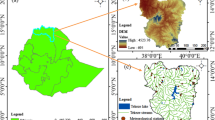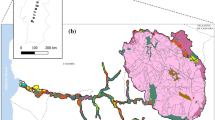Abstract
Erosion and the impacts of the redistribution of sediment are a serious threat to the quality of water resources. They cause losses and/or additional expenses in many areas, such as water treatment, biodiversity or fisheries. The implementation of catchment management measures, aimed at preventing the transfer of sediment to rivers, can be a cost-beneficial way to address the problem. In order to select the measures and appropriate locations for erosion control, the spatially distributed soil erosion and sediment delivery model WaTEM-SEDEM was used. The model was calibrated against total suspended solids data at the outlet of the Wey catchment, South-east England, yielding satisfactory results. Different scenarios of catchment management were modelled to reduce the amount of sediment transported to the river. Scenarios introducing 24 retention ponds, 50-m-wide buffer strips and cover crops in areas with the largest erosion and sediment delivery were tested. The largest decrease in both sediment production and sediment export was obtained using cover crops, with reductions of 13.4% and 14.1%, respectively. A cost-benefit analysis considering multiple ecosystem services (e.g. control of erosion rates, attenuation of mass flow, pest control, wildlife and its outputs) identified the cover crops as the most cost-beneficial measure and a possible funding scheme based on payments for ecosystem services was developed as a way to enable its implementation.







Similar content being viewed by others
References
Green, G.P., & Heffernan, W.D. (1987). Journal of Rural Studies, 3(2), 151.
Owens, P.N., & Collins, A.J. (2006). Soil erosion and sediment redistribution in river catchments: measurement modelling and management CABI.
Boardman, J. (2013). Agriculture, 3(3), 418.
Quijano, L., Beguería, S., & Gaspar, L. (2016). A Navas, Catena, 138, 38.
Nduhiu, C., Gathenya, J.M., Mwangi, J.K., Aman, M., & Mutisya, T. (2016). European Geosciences Union.
Lee, C.G., Fletcher, T.D., & Sun, G. (2009). Engineering in Life Sciences, 9(1), 11.
Rolls, S., & Sutherland, T. (2014). Bristol: Natural England (Natural England Research Reports 057).
Van Oost, K., Govers, G., & Desmet, P. (2000). Landscape ecology, 15(6), 577.
Natural Capital Committee. (2019). Advice on soil management. UK Government. https://assets.publishing.service.gov.uk/government/uploads/system/uploads/attachment_data/file/801515/ncc-advice-soil-management.pdf.
Pimentel, D., Lach, L., Zuniga, R., & Morrison, D. (2000). BioScience, 50(1), 53.
Sayre, S.S. (2018). Environmental and Resource Economics 1–35.
de Lima, L.S., Krueger, T., & García-Marquez, J. (2017). Ecosystem services, 27, 139.
Hack, J. (2015). Water International, 40(5-6), 929.
Smith, L., Inman, A., & Cherrington, R. (2012). Environmental science & policy, 24, 92.
Department for Environment, Food and Rural Affairs. (2013). Developing the potential for Payments for Ecosystem Services: an Action Plan. UK Government. https://assets.publishing.service.gov.uk/government/uploads/system/uploads/attachment_data/file/200889/pb13918-pes-actionplan-20130522.pdf.
Centre for Local Economic Strategies and Wildlife Trust for Lancashire, Manchester and North Merseyside. (2015). Payment for Ecosystem Services-Irwell Catchment. UK Government. https://ecosystemsknowledge.net/natcap-project/irwell-catchment-investigating-payment-ecosystem-services.
Posthumus, H., Deeks, L., & Rickson, R. (2015). Journal Quinton, Soil use and management, 31, 16.
Nix, J., & et al. (2008). The John Nix farm management pocketbook. Ed 39 The Andersons Centre.
Lüke, A. (2018). Journal Hack, Sustainability, 10(2), 346.
Notebaert, B., Vaes, B., Verstraeten, G., & Govers, G. (2006). waTEM-SEDEM version 2006 Manual. In Leuven, K.U. (Ed.) Physical and Regional Geography Research Group.
U.A.R.S. (ARS) Soil and water assessment tool https://swat.tamu.edu/ (2019).
S. University. Integrated valuation of ecosystem services (invest) https://naturalcapitalproject.stanford.edu/invest/ (2019).
S. University. Rios : Resource investment optimization system https://naturalcapitalproject.stanford.edu/software/ (2019).
Jones, J. (2014). River Wey Catchment Vision. Consultation Draft. Wey Landscape Partnetship. https://surreynaturepartnership.files.wordpress.com/2018/05/wlp-catchment-plan_sert_-draft-v3.pdf .
Land Information System. Landis map viewer. http://www.landis.org.uk/mapviewer/ (2018). Accessed: 2018-05-25.
Verstraeten, G., & Prosser, I.P. (2008). Geomorphology, 98(3-4), 199.
Renard, K.G., Foster, G.R., Weesies, G.A., & Porter, J.P. (1991). Journal of soil and Water Conservation, 46(1), 30.
Panagos, P., Borrelli, P., Meusburger, K., Alewell, C., Lugato, E., & Montanarella, L. (2015). Land use policy, 48, 38.
Panagos, P., Meusburger, K., Ballabio, C., Borrelli, P., & Alewell, C. (2014). Science of the total environment, 479, 189.
Panagos, P., Ballabio, C., Borrelli, P., Meusburger, K., Klik, A., Rousseva, S., Tadić, M. P., Michaelides, S., Hrabalíková, M., Olsen, P., & et al. (2015). Science of the Total Environment, 511, 801.
The University of Edinburgh. Digimap. https://digimap.edina.ac.uk/os (2018). Accessed: 2018-06-23.
The University of Edinburgh. Digimap. https://digimap.edina.ac.uk/environment (2018). Accessed: 2018-06-23.
Pear Technology. Free rural payment agency maps for digital mapping. https://www.peartechnology.co.uk/free-rural-payment-agency-maps/ (2018). Accessed: 2018-06-23.
European Soil Data Centre (ESDAC). Cover management factor (C-factor) for the EU. https://esdac.jrc.ec.europa.eu/content/cover-management-factor-c-factor-eu (2018). Accessed: 2018-06-23.
European Soil Data Centre (ESDAC). Soil erosion by water (rusle2015). https://esdac.jrc.ec.europa.eu/content/soil-erosion-water-rusle2015 (2018). Accessed: 2018-06-23.
European Soil Data Centre (ESDAC). (global rainfall erosivity). https://esdac.jrc.ec.europa.eu/content/global-rainfall-erosivity (2018). Accessed: 2018-06-23.
National River Flow Archive. Wey at guildford. http://nrfa.ceh.ac.uk/data/station/meanflow/39141 (2018). Accessed: 2018-05-25.
Vercruysse, K., Grabowski, R.C., & Rickson, R. (2017). Earth-Science Reviews, 166, 38.
Mainstone, C. (2008). Investigations into the use of critical sediment yields for assessing and managing fine sediment inputs into freshwater ecosystems. Natural England. http://publications.naturalengland.org.uk/publicatin/35023.
Dickinson, W. (1982). Occurrence and control of Soil erosion and fluvial sedimentation In selected basins of the Thames river watershed. Stratford-Avon River Environmental Management Project. https://atrium.lib.uoguelph.ca/xmlui/bitstream/handle/10214/14544/SAREMP_R_5.pdf?sequence=1&isAllowed=y.
Rural Payments Agency, Department for Environment, Food and Rural Affairs, Forestry Commission, Natural England. (2018). Countryside Stewardship: Mid Tier and New CS Offers for Wildlife Manual. UK Government. https://www.gov.uk/government/publications/countryside-stewardship-mid-tier-including-water-quality-capital-items-manual.
Rural Payments Agency, Department for Environment, Food and Rural Affairs, Forestry Commission, Natural England. (2018). Countryside Stewardship: Mid Tier and New CS Offers for Wildlife Manual. https://www.gov.uk/government/publications/thames-river-basin-district-flood-risk-management-plan.
Malaure, S. (2012). Catchment implementation plan: Wey Catchment. Surrey Wildlife Trust. http://www.catchmentchange.net/wp-content/uploads/2012/10/Wey-Catchment-Implementation-Plan_Version-April-2012.pdf.
Verstraeten, G., Oost, K., Rompaey, A., Poesen, J., & Govers, G. (2002). Soil Use and Management, 18(4), 386.
Van Rompaey, A., Krasa, J., Dostal, T., & Govers, G. (2003). In the interactions between sediments and water, (pp. 169–176). New York: Springer.
Keating, K., Keeble, H., Pettit, A., & Stark, D. (2015). Delivering benefits through evidence. Cost estimation for SUDS - summary of evidence. Environment Agency.
Department for Environment, Food and Rural Affairs. (2013). Payments for Ecosystem Services: A Best Practice Guide. UK Government. https://www.cbd.int/financial/pes/unitedkingdom-bestpractice.pdf.
Haines-Young, R., & Potschin, M. (2013). Common international classification of ecosystem services (CICES): consultation on version 4, August-December 2012. European Environment Agency. https://cices.eu/content/uploads/sites/8/2009/11/CICES_Update_Nov2011.pdf.
The University of Edinburgh. Digimap.https://digimap.edina.ac.uk/ (2018). Accessed: 2018-06-23.
Collins, A.L., Zhang, Y., & Naden, P. (2015). Proceedings of the International Association of Hydrological Sciences, 367, 382.
Bezak, N., Rusjan, S., Petan, S., Sodnik, J., & Mikoš, M. (2015). Environmental Earth Sciences, 74(6), 5245.
Balshaw, H., Newell, P., Critchley, N., Harris, D., Twining, S., & Chambers, B. (2013). Post Harvest Management for soil degradationreduction in agricultural soils: methods, occurrence, cost and benefits. ADAS. http://sciencesearch.defra.gov.uk/Default.aspx?Menu=Menu&Module=More&Location=None&Completed=0&ProjectID=18793#Description.
Verstraeten, G., Poesen, J., Gillijns, K., & Govers, G. (2006). Hydrological Processes: An International Journal, 20(20), 4259.
Morschel, J., Fox, D., & Bruno, J.F. (2004). Environmental Science & Policy, 7(1), 39.
Morschel, J., Fox, D., & Bruno, J.F. (2004). Environmental Science & Policy, 7(1), 39.
Momblanch, A., Connor, J.D., Crossman, N.D., Paredes-Arquiola, J., & Andreu, J. (2016). Journal of Hydrology, 538, 293.
Mertens, A., Van Meensel, J., Willem, L., & Lauwers, L. (2018). J. Buysse, Biomass and bioenergy, 109, 209.
Golecha, R., & Gan, J. (2016). Renewable and Sustainable Energy Reviews, 57, 34.
Affairs, W.U.C. (2019). Water industry takes significant first step in drive to be carbon zero https://www.water.org.uk.
Omokanye, A., Lardner, H., Sreekumar, L., & Jeffrey, L. (2019). Journal of Applied Animal Research, 47(1), 303.
Stockwell, R., & Bitan, E. (2011). National Wildlife Federation.
Debes, J. (2016). No-till farmer.
Reed, M.S., Allen, K., Attlee, A., Dougill, A.J., Evans, K.L., Kenter, J.O., Hoy, J., McNab, D., Stead, S.M., Twyman, C., & et al. (2017). Global environmental change, 43, 92.
Karousakis, K. (2012). Enhancing the effectiveness of payments for ecosystem services (PES). Tech. rep., Environment Directorate, Organisation for economic cooperation and development (OECD) france.
Department for Environment, Food and Rural Affairs. (2016). Defra’s Payments for Ecosystem Services Pilot Projects 2012-15. UK Government. https://assets.publishing.service.gov.uk/government/uploads/system/uploads/attachment_data/file/578005/pes-pilot-review-key-findings-2016.pdf.
Acknowledgements
The authors thanks Affinity Water for supporting this research and the Environment Agency for the provision of sediment sampling data, which enabled this article to be implemented.
Author information
Authors and Affiliations
Corresponding author
Additional information
Publisher’s Note
Springer Nature remains neutral with regard to jurisdictional claims in published maps and institutional affiliations.
Rights and permissions
About this article
Cite this article
Benisiewicz, B., Momblanch, A., Leggatt, A. et al. Erosion and Sediment Transport Modelling to Inform Payment for Ecosystem Services Schemes. Environ Model Assess 26, 89–102 (2021). https://doi.org/10.1007/s10666-020-09723-9
Received:
Accepted:
Published:
Issue Date:
DOI: https://doi.org/10.1007/s10666-020-09723-9




